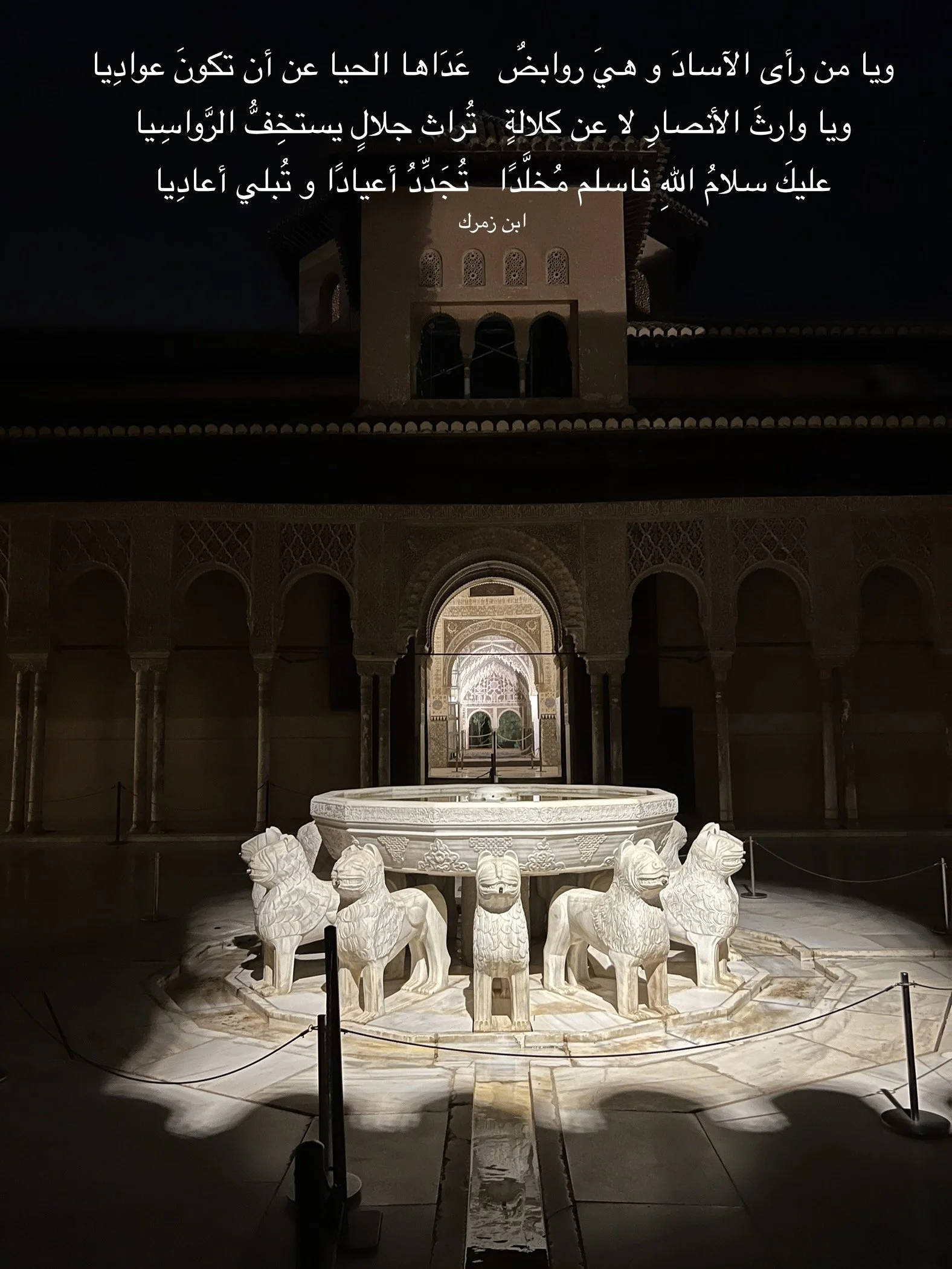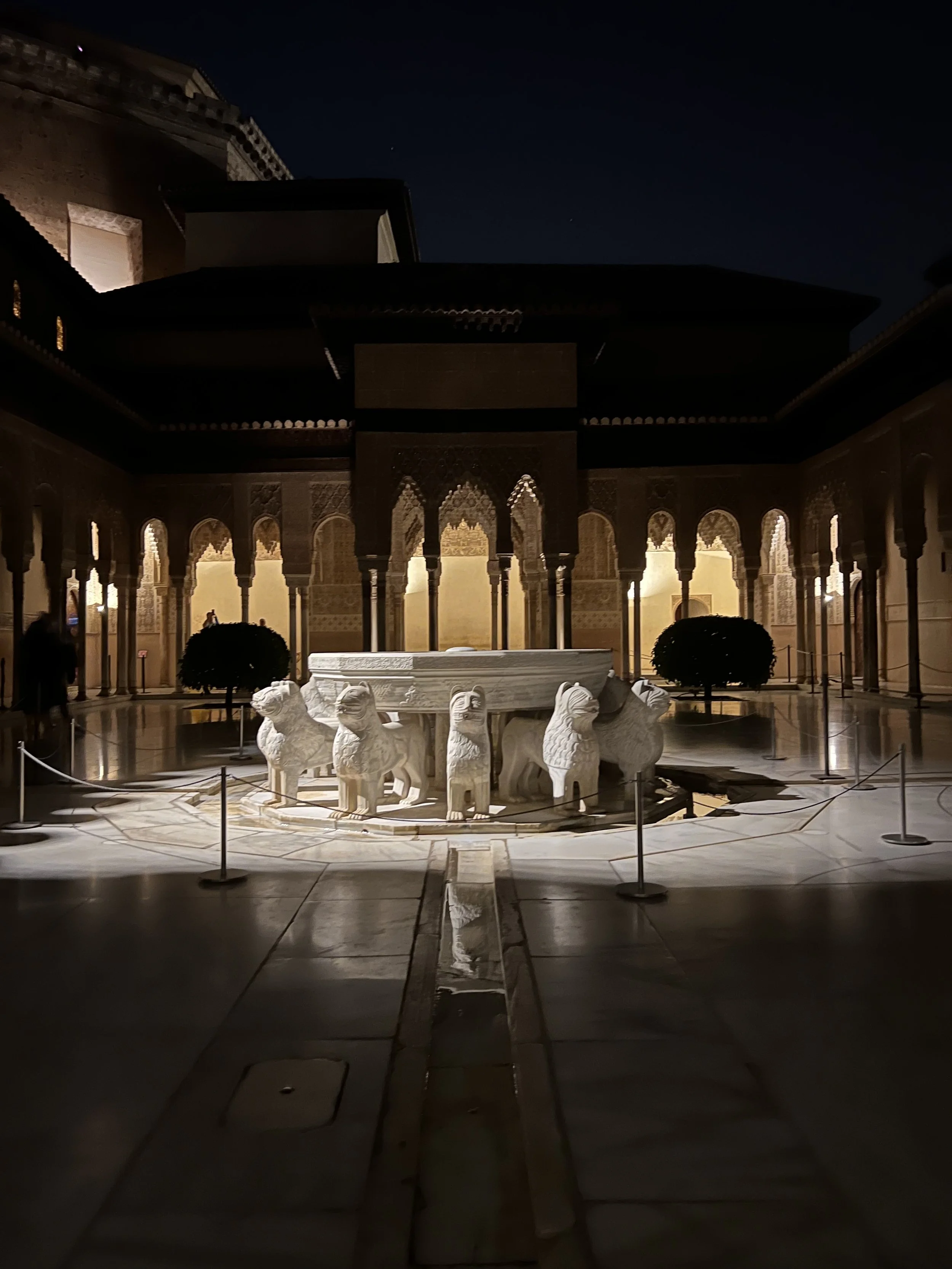The Palace of the Lions
The Nasrid Palaces are the jewels of Alhambra. They’re a unique architectural and artistic phenomenon in Europe. The sultan of Granada Yusuf I who built the Hall of Comares, also known as the Throne Room and Ambassadorial Room, died before it was finished. After his death, his son the sultan Muhammad V finished the work that his father started and went on to build what will be his greatest work - The Palace of the Lions, or as he called it then Alriyad Alsaid (meaning the Garden of Happiness).
Arabian and Islamic buildings are built with courtyards at the center, which follows a form of architecture that unfolds on the inside. This style can be noticed in the Arabian Peninsula in Najdi houses, it is also typical of houses in Damascus and Aleppo.. and has traveled all the way to the west to Alandalus. This was, however, odd in Europe as typically a building’s facade presented itself as powerful from the first glance. Whereas the Arabian architecture conformed to a more mystical way of living, with simpler facades and hidden marvels on the inside. Privacy and humbleness are what drove these types of buildings.
Muhammad V had a limited area to build his new palace on. He was restricted from three sides by other buildings, and so he had the genius idea of employing mathematics to maximize his space and bring harmony to it. His architects cultivated the art of proportions in every part from the ground plan, the height of the arches, the building’s elevation, the placement of the fountains, the positioning of the columns, and the ornamentation. It was based on the relationship of the diagonal of a square and the proportional progression of rectangles - in order to do that, the base stays constant throughout. Starting with a square, its diagonal makes the side of the new rectangle, and the diagonal of the newly formed rectangle makes the side of a larger rectangle, and so on.. the fourth rectangle is double the size of the first. These diagonals are in the sequence of √2, √3, √4, and √5*.
The courtyard is surrounded by 124 columns that are made up of marble. On the east and west sides of the courtyard, two square pavilions were formed with semi-spherical wooden cupolas and small fountains that channel water from the central fountain (The Fountain of the Lions). The pavilions were made to proportional perfection. Not only does the placement of columns obey the proportional ratio, but it also dictated where does the shaft of the column end and where does the capital (which is the crowning part of the column) begins. It also decided the width of the arches as it needed to be in complete symmetry with the arches of the entrances to the halls beyond each pavilion - allowing an unobstructed view throughout the palace.
Another feature of the Arabian architecture is the slender columns - this difference can be seen in the columns of the palace of Carlos V (A palace built over one of the Nasrid palaces in Alhambra after the Spanish Inquisition). Rather than being just shafts that support a ceiling, Arabian columns and arches portray rows of trees, usually palm trees, with colorful muqarna arches that have engraved writings - typically Quranic verses, poetry, or phrases - which act as fruits of wisdom. This was especially evident in the Palace of the Lions, which was after all named by its builder “The Garden of Happiness”. This palace was situated near the actual gardens of Alhambra (the Partal gardens), and Muhammad V designed it in a way that allows it to flow naturally with its surroundings.
Roman and Greek works of architecture are thought of as great due to their advanced understanding of geometry and mathematics, but for centuries it was believed that Alhambra was built randomly, however, there’s nothing random about it at all. Turns out the mathematics that wasn’t obvious to the naked eye was at play. What was obvious to anyone walking through it, is the sense of harmony and serenity, but what forms this all is hidden. It’s a different school of thought, Arabs enjoy subtlety as a way to impress. The idea of enchanting the senses at first, and only allowing the mathematical work to seep into the subconscious, gave the owners of such buildings a sense of power that they are allowed deep into your thoughts.
* This is based on the work done by Professor Antonio Fernandez-Puertas of the University of Granada who studied and discovered the mathematics of Alhambra
Music by Maya Youssef - Silver Lining





